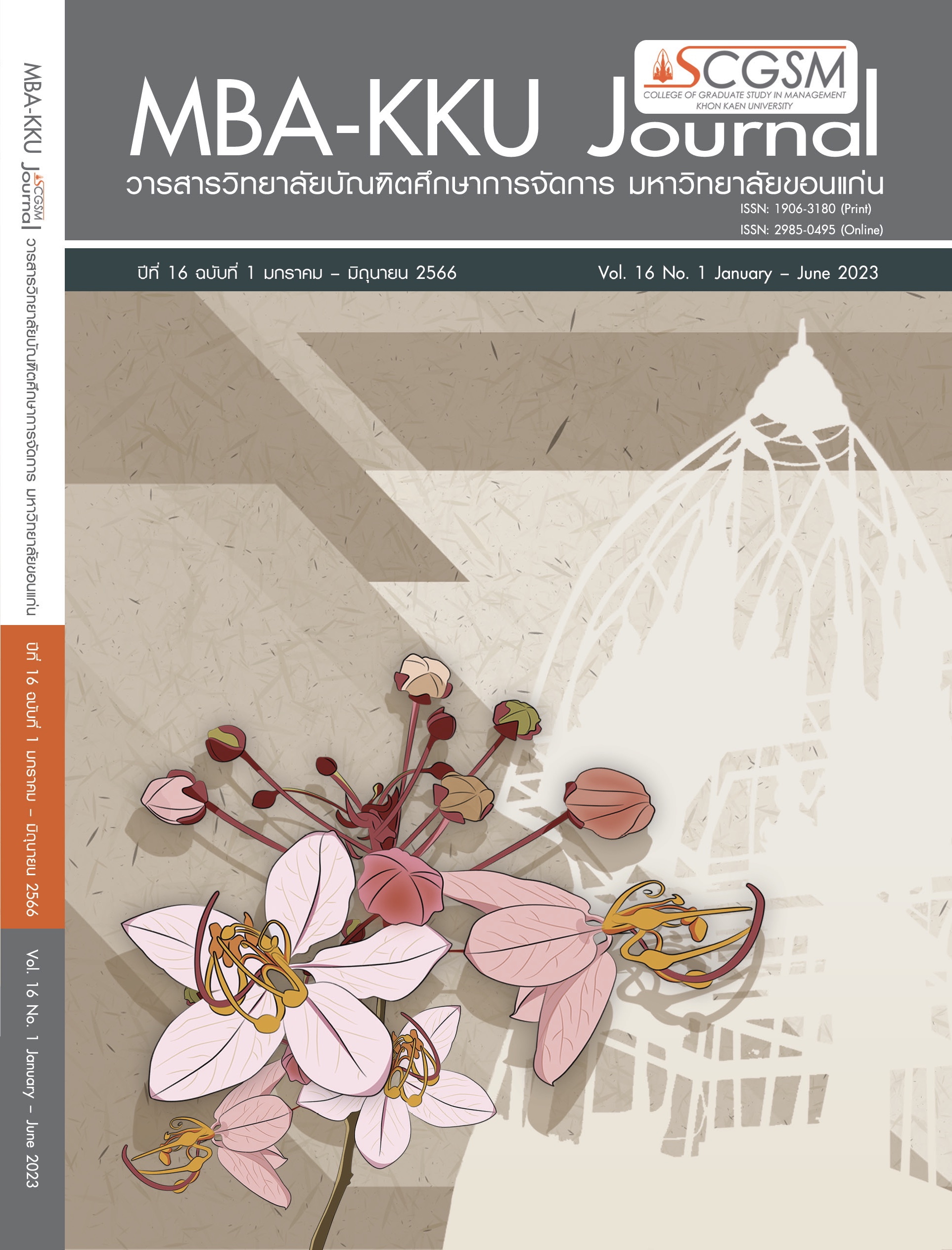Exploring the Healthy Food Diet Needs of Generation Y and Generation Z Consumers: A Case Study in Muang District, Mukdahan Province
Main Article Content
Abstract
The primary objective of this research is threefold: (1) to investigate the consumer behavior regarding healthy food diet products among Generation Y and Generation Z consumers, (2) to explore the factors that influence their needs for healthy diet products, and (3) to examine the specific requirements of Generation Y and Generation Z consumers in terms of healthy diet products. This study adopted a quantitative research approach, with a sample group comprising 400 individuals aged between 10 and 35 years, residing in Amphoe Mueang, Mukdahan Province, and identified as Generation Y and Generation Z based on their lifestyle. Data collection was conducted using a questionnaire as the research instrument. The gathered data were analyzed using statistical measures, including Frequency, Percentage, Mean, Standard Deviation, t-Test, F-test, and Pearson's correlation coefficient. The findings of this research revealed the following insights: (1) The consumer behavior related to healthy food diet products indicated that the majority of the respondents chose to eat healthy food with all five food groups. They spent less than 100 baht per meal on healthy food. Internet and social networks serve as primary sources of information for accessing healthy food options. The main reason for choosing healthy food was for their health benefits, and their attitude toward healthy food was that healthy food provided them with nutritional value. The frequency of healthy food consumption typically ranged from two to three times per week, with Facebook being the dominant social network platform used. (2) The overall behavioral pattern influencing consumer needs for healthy diet products exhibited a prominent significance at a high level. (3) The overall demand for healthy diet products among consumers was at a high level. When considering individual aspects, consumption warranty emerges as the highest priority, followed by accessory and value. The hypothesis tests conducted to compare consumer needs for healthy diet products based on personal factors (i.e., education levels) revealed significant differences in decision-making among respondents at different levels, with a statistical significance level of 0.05. The analysis of the relationship between consumption behavior and consumer needs in healthy diet products among Generation Y and Generation Z consumers indicated a strong positive correlation between the two variables.
Article Details

This work is licensed under a Creative Commons Attribution-NonCommercial-NoDerivatives 4.0 International License.
- The ideas and opinions expressed in MBA-KKU Journal are those of the authors and not necessarily those of the editor.
- Copyright on any open access article in a journal published by MBA-KKU Journal
References
กมล เลิศรัตน์, อารันต์ พัฒโนทัย และสนั่น จอกลอย. (2561). เส้นทางสู่การสร้างนวัตกรรมอาหารเพื่อสุขภาพเพื่อความอยู่เย็นเป็นสุขของสังคมไทยอย่างยั่งยืน. ขอนแก่น: ขอนแก่นการพิมพ์.
กันต์วิรุฬห์ พลูปราชญ์. (2563). พฤติกรรมและความต้องการทางด้านผลิตภัณฑ์อาหารเพื่อสุขภาพของผู้บริโภคในเขตกรุงเทพมหานคร. วารสารวิทยาลัยดุสิตธานี, 2(14), 59-67.
จิราพร วีณุตตรานนท์. (2559). ปัจจัยที่มีความสัมพันธ์กับพฤติกรรมการบริโภคอาหารเพื่อสุขภาพของนักศึกษาระดับปริญญาตรีมหาวิทยาลัยราชภัฏในเขตกรุงเทพมหานคร. วิทยานิพนธ์คหกรรมศาสตร์มหาบัณฑิต สาขาวิชาคหกรรมศาสตร์ คณะเทคโนโลยีคหกรรมศาสตร์ มหาวิทยาลัยเทคโนโลยีราชมงคลพระนคร.
จีรศักดิ์ คำสุริย์, เมธาวี ชุณหวุฒิยานนท์ และดุจเดือน บุญสม. (2563). กลยุทธ์การพัฒนาอาหารเพื่อสุขภาพและโภชนาการสมวัย. สำนักงานเศรษฐกิจอุตสาหกรรมกระทรวงอุตสาหกรรม โดย อุตสาหกรรมพัฒนามูลนิธิเพื่อสถาบันอาหาร. ค้นเมื่อ 5 สิงหาคม 2565, จาก https://www.oie.go.th.
ชนัดดา ศิริพล. (2564). ปัจจัยที่ส่งผลต่อพฤติกรรมการซื้ออาหารเพื่อสุขภาพของประชากรในเขตกรุงเทพมหานครและปริมณฑล. การศึกษาอิสระบริหารธุรกิจมหาบัณฑิต สาขาการจัดการทั่วไป คณะบริหารธุรกิจ มหาวิทยาลัยรามคำแหง.
ฐปนัท แก้วปาน, สราวุธ อิศรานุวัฒน์ และจริยา แผลงนอก. (2563). หลักการและแนวคิดในการออกแบบผลิตภัณฑ์. วารสารมนุษยศาสตร์และสังคมศาสตร์ มหาวิทยาลัยราชภัฏสุรินทร์, 2(22), 162-182.
ณัฐนรี ชูถม. (2559). ปัจจัยที่มีผลต่อการตัดสินใจซื้ออาหารเพื่อสุขภาพ (คลีนฟู้ดส์) ของผู้บริโภคในเขตนิคมอมตะนคร จังหวัดชลบุรี. งานนิพนธ์บริหารธุรกิจมหาบัณฑิต สาขาวิชาบริหารธุรกิจสำหรับผู้บริหาร วิทยาลัยพาณิชยศาสตร์ มหาวิทยาลัยบูรพา.
ธัญลักษณ์ ถาวรจิต. (2564). การศึกษาพฤติกรรมผู้บริโภคอาหารเพื่อสุขภาพในเทศบาลนครหาดใหญ่ จังหวัดสงขลา. วารสารราชมงคลศรีวิชัย, 1(3), 41-56.
วิทยาลัยการจัดการ มหาวิทยาลัยมหิดล. (2562). “ใครไม่ SEE GEN Z”. ค้นเมื่อ 5 สิงหาคม 2565, จาก https://www.limitlesseducation.net/.
ศุภพล เมธีเสริมสกุล. (2563). ปัจจัยที่มีความสัมพันธ์ระหว่าง โภชนบัญญัติ 9 ประการ กับการตัดสินใจสั่งอาหารผ่านแอปพลิเคชันออนไลน์ ของนักเรียนมัธยมศึกษาตอนปลายเขตพื้นที่การศึกษามัธยมศึกษาเขต 1 ภายใต้ฐานวิถีชีวิตใหม่. วิทยานิพนธ์คหกรรมศาสตร์มหาบัณฑิต สาขาวิชาคหกรรมศาสตร์ คณะเทคโนโลยีคหกรรมศาสตร์ มหาวิทยาลัยเทคโนโลยีราชมงคลพระนคร.
สำนักงานจังหวัดมุกดาหาร. (2564). แผนพัฒนาจังหวัดมุกดาหาร ปี พ.ศ. 2561-2565. ค้นเมื่อ 5 สิงหาคม 2565, จาก https://data.go.th/en/dataset/http-www-mukdahan-go-th-ita2564-p61-65-2565-pdf.
สำนักงานสถิติแห่งชาติ. (2564). สำรวจการมีการใช้เทคโนโลยีสารสนเทศและการสื่อสารในครัวเรือน พ.ศ 2564 (ไตรมาส 2). ค้นเมื่อ 5 สิงหาคม 2565, จาก http://www.nso.go.th.
สำนักทะเบียนท้องถิ่น เทศบาลเมืองมุกดาหาร. (2563). ปิรามิดประชากร เมืองมุกดาหาร ปี 2563. ค้นเมื่อ 5 สิงหาคม 2565, จาก http://muangmuk.go.th/home/.
สุรพงษ์ คงสัตย์ และธีรชาติ ธรรมวงค์. (2551). การหาค่าความเที่ยงตรงของแบบสอบถาม (IOC). ค้นเมื่อ 5 สิงหาคม 2565, จาก https://www.mcu.ac.th/article/detail/14329.
อาดูโฮโด อาเซียน. (2563). Now you Z me: Debunking myths about ASEAN’s Generation Z” (พลิกมุมมองใหม่พิชิตใจผู้บริโภค Gen Z ในอาเซียน). ค้นเมื่อ 5 สิงหาคม 2565, จาก https://www.marketthink.co/.
Kotler, P. (1997). Marketing management: analysis, planning, implementation and control. (9th ed.). New Jersey: A Simon & Schuster Company.
Morin. (2014). Generation c: The nine spheres of social media influence. Retrieved August 5, 2022, from: http://maximizesocialbusiness.com อ้างถึงใน วรมน บุญศาสตร์. (2559). องค์กรรับผิดชอบต่อสังคม: ทัศนคติและการตอบสนองด้านคุณภาพการบริการ ภาพลักษณ์องค์กร ความไว้วางใจ ความตั้งใจซื้อและการบอกต่อของกลุ่มผู้บริโภคเจนเนอเรชั่นซี. วารสารการสื่อสารและการจัดการ นิด้า, 2(2), 1-18.
Nielsan. (2010). Introducing generation C the connected collective consumer. Retrieved August 5,


